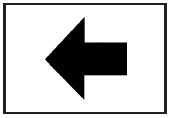Turn and Lane-Change Signals
The turn signal has two upward (for right) and two downward (for left) positions. These positions let you signal a turn or a lane change.
To signal a turn, move the lever all the way up or down. When the turn is finished, the lever returns automatically.

An arrow on the instrument panel cluster flashes in the direction of the turn or lane change.
To signal a lane change, raise or lower the lever until the arrow starts to flash. Hold it there until you complete your lane change. The lever returns by itself when released. The bottom of the outside rearview mirrors might also have lane change indicators.
As you signal a turn or a lane change, if the arrows flash more quickly than normal, a signal bulb could be burned out and other drivers will not see your turn signal.
If a bulb is burned out, replace it to help avoid an accident. If the arrows do not go on at all when you signal a turn, check the fuse.
If you have a trailer towing option with added wiring for the trailer lamps, a turn signal flasher is used. With this flasher installed, the signal indicator flashes even if a turn signal bulb is burned out. Check the front and rear turn signal lamps regularly to make sure they are working.
Turn Signal On Chime
If your turn signal is left on for more than 3/4 of a mile (1.2 km), a chime sounds at each flash of the turn signal. To turn off the chime, move the turn signal lever to the off position.
See also:
Remote Vehicle Start
If available, this feature allows the
engine to be started from outside
the vehicle.
The button will be on the RKE
transmitter if the vehicle has remote
start.
Laws in some local communitie ...
Radio Menus (Radio with CD and Touchscreen)
Tone Menu
To access the sound menu, press the TONE button.
Use the sound menu to adjust the following features:
Bass
Middle
Treble
EQ
Fade
Balance
Setting the Tone
To adjust the ba ...
Automatic Engine Start/Stop Feature
Vehicles with eAssist have an
automatic engine start/stop feature.
After the engine is started and has
reached operating temperature, the
auto stop feature may cause the
engine to turn off wh ...


